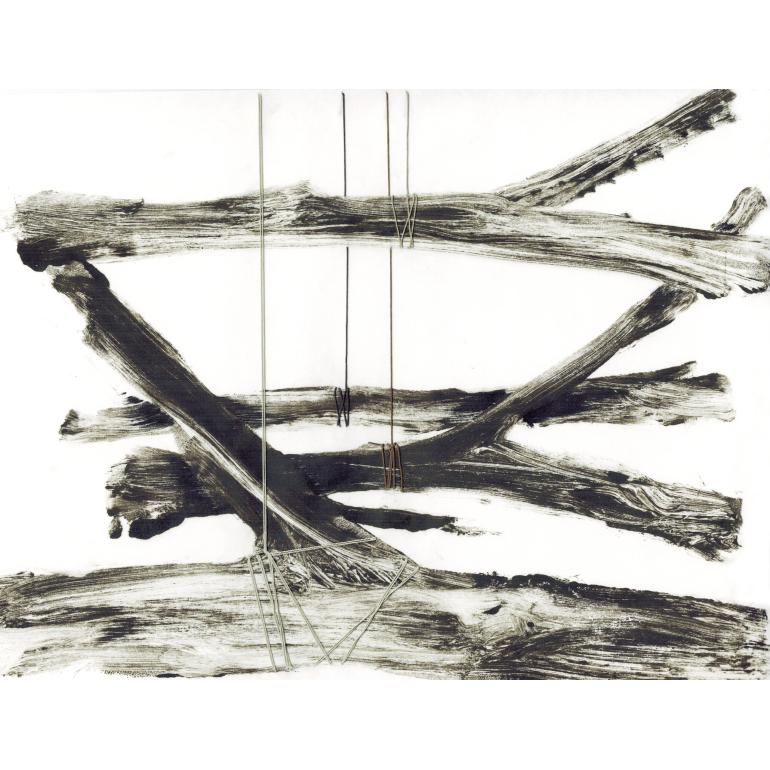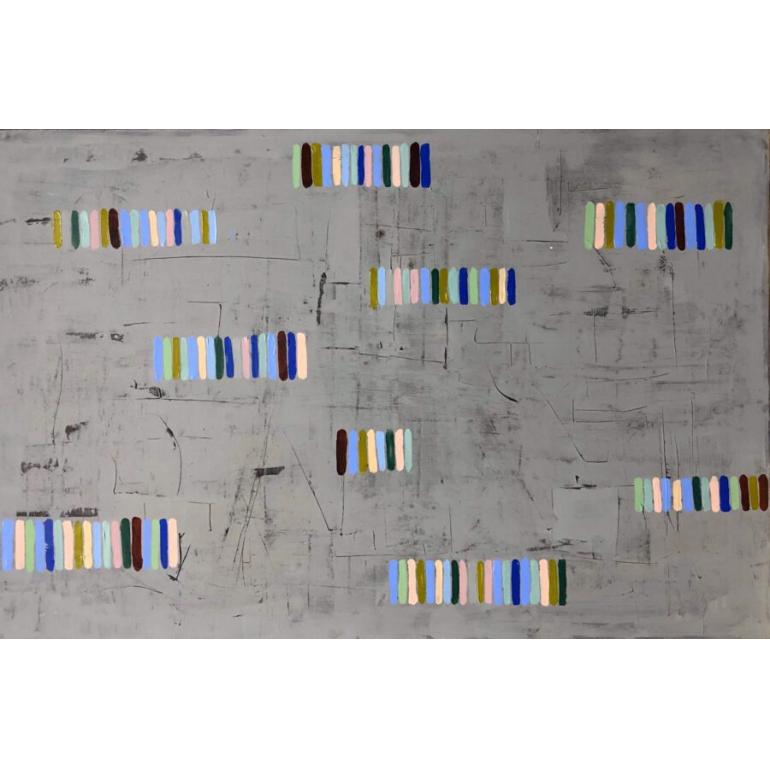FOR IMMEDIATE RELEASE
March 25, 2019
Contact: Tamar Russell Brown, Gallery Sitka — 978.425.6290
Musically Inspired Painter Brings Ten Great “Women of Jazz” to Life in Zavo Show Opening April 2
SHIRLEY, Mass. — Kate Shaffer has loved to make art her whole life, just as she has always loved jazz, particularly jazz vocalists such as Ella Fitzgerald, Etta James
“Women of Jazz” focuses on the ten great women interpreters of jazz of the twentieth century. Most of them faced tremendous adversity throughout their lives — poverty, abuse, racism — but managed to triumph over all these difficulties, each one relying on their strong, striking personalities in addition to their considerable musical talents. The ten are captured in portraits, or what the artist also refers to as the style of “abstract figurative.”
“Each woman is ‘mid-song,’” Kate explains. “The open mouths are not just about the music, but also about their voices being heard in the world.” Each image is derived from photographs (except for Betty Carter’s, which Kate sketched from one of the singer’s videos). These are not individuals posing but captured in action, brilliantly expressing what Ms. Shaffer calls the “aliveness” of these extraordinary performers.
What comes through in each of the paintings is a strong sense of who these women were, what extraordinarily brave people they were, and how they used music to have their say about the world around them.
“When I say that each of these women found her ‘voice,’” says Kate, “I mean they found out how to be heard in this world — what they felt, what they thought about.” These women became very influential, not just in the jazz world but sometimes in terms of political and social movements as well. Nina Simone was one of the most inspiring voices of the civil rights movement, and Billie Holiday lost work at many clubs after singing and recording “Strange Fruit,” the shockingly graphic song about the lynching of young Black men still occurring in the U.S. in the 1950s.
“Jazz is described as both ‘hot’ and ‘cool,’” Ms. Shaffer says. Fittingly, “colors of that temperature,” both hot and cool, are employed in the pictures. Both kinds of colors are so striking that they practically sing. “I wanted very vibrant colors, not dull, sedate ones,” Kate explains.
These women came to the notice of bandleaders and producers through such venues as talent shows and often singing for free at various clubs when they were still just teenagers. Everyone knows about the famous talent contests at The Apollo Theater on 125th Street in Harlem, which brought lots of new talent into the spotlight in the 1930s and ’40s. Ella Fitzgerald’s first experience there demonstrates how the music business found new talent in those days. First prize at those contests was $10 and (much more important) a week-long gig at The Apollo. Fitzgerald was homeless for some time as a teenager in Harlem. “Ella was so scruffy-looking,” says Kate, that even though she won the contest she didn’t get her prize because the theater owner was embarrassed to have her on stage. The Apollo producers were the ones who were really embarrassed later on when Fitzgerald became one of the biggest, brightest stars in American music.
“Most people don’t know anything about these women,” says Ms. Shaffer. Introducing them to art lovers was a big motivation for producing “Women of Jazz.”
Other paintings in the show are cityscapes of the two grand cities of jazz where these legendary performers sang. “New York Skyline” will remind art lovers of the home of The Cotton Club and “Chicago Skyline” will conjure up memories of the Second City’s great club, Dreamland.

The ten “Women of Jazz” painted by Ms. Shaffer are profiled as follows.
Dinah Washington was born Ruth Lee Jones in 1924 and played piano and sang as a youngster in church. She got her big break when she won a talent contest at age 15. She began performing in Chicago with such greats as Fats Waller and playing clubs like The Three Deuces. When she went to see Billie Holiday at the Garrick Stage Bar she got the opportunity to sing for club owner Joe Sherman. He hired her on the spot and Dinah worked the upstairs room while Billie sang in the main lounge. She went on to record with such non-jazz artists as Hank Williams but also with jazz immortals such as Duke Ellington and Count Basie. Dinah went on to record many hits and won a Grammy in 1959 for “Unforgettable.” Her chops as a cross-over artist is evident from her being inducted into the Big Band and Jazz Hall of Fame (1984) as well as the Rock & Roll Hall of Fame (1993). She died from a drug overdose at the tragically young age of 39.
Etta James was born in 1938 and started recording in 1954, climbing the charts with songs like “Tell Mama,” “Something’s Got Ahold of Me,” “A Sunday Kind of Love,” and her biggest hit, “At Last.” Her personal life threatened to obscure her career. She struggled with heroin addiction and severe domestic violence. Etta was subject to the abuse of a vocal teacher at a young age and also went through a string of abusive foster homes. In spite of all this turmoil, Etta won six Grammys and was inducted into the Rock & Roll Hall of Fame in 1993. “At Last” is still played on the radio and is a perennial favorite at wedding receptions.
At age 15, Ella Fitzgerald found herself alone in the world, after her mother’s death from injuries sustained in a car accident. Ella moved to Harlem to live with an aunt. She ended up in reform school, broke out, returned to Harlem, and was homeless for a time before her winning performance singing in the talent show at The Apollo. About a year later she won the opportunity to sing at the Harlem Opera House where she met bandleader Chick Webb. He decided to take a chance on her, cleaned her up, and let her sing with his band. Ella never looked back. She sang with greats from every era and genre — jazz, pop, soul and blues. With her exquisite purity of tone, diction and intonation, she was well-known to, and loved by, audiences all over the world. She had a remarkable career that lasted for over 50 years. She died in 1996, still known to music lovers as the Queen of Jazz and the First Lady of Song.
Nina Simone was, to say the least, a natural musician. She taught herself to play the piano at the age of three. By the time she reached adolescence she could play almost anything by ear. She studied classical piano during high school. She applied to the prestigious Curtis Institute of Music in Philadelphia and was turned away. Nina always thought she was rejected because of her race. She developed a fusion style that combined jazz, blues and classical music. In 1963, she was shaken by the assassination of civil rights leader Medgar Evers. She became a very outspoken champion of civil rights for African Americans. This very open, militant political stand cost her many bookings. She recorded what turned out to be her seminal work in 1978. Nina never liked “Mississippi Goddamn” or the album, “Baltimore,” but fans and critics alike raved. Nina felt the goal of a musician is “to make people feel on a deep level. It’s difficult to describe because it’s not something you can analyze; to get near what it’s about you have to play it.” Nina died in her sleep at her home in France in 2003.
Billie Holiday was born Eleanor Fagan in 1915. She took on the name Billie Holiday and was also given the sobriquet “Lady Day” by her friend and music partner, Lester Young. Billie’s voice is one of the most distinctive and recognizable voices in the history of music. Although she had a very limited range of only about one octave, she developed vocal styling inspired by the phrasing of musical instruments. She was a gifted vocal improviser and a standout among jazz singers. Her vocalization has been an inspiration to current stars like Mariah Carey and Lady Gaga. Billie had massive success during the ’30s and ’40s with both Columbia and Decca Records, but by the 1940s she struggled with drug abuse and legal troubles. In the 1950s she had a major triumph with two sold-out concerts at Carnegie Hall. She died of alcoholism in 1959. Strangely, some of her recordings had not been released by the time of her death. Some believe her work was censored because she refused to stop singing “Strange Fruit.” But most of her songs have now been released, enhancing her reputation for whole new generations of music lovers.
Peggy Lee was born Norma Egstrom in 1920. She changed her name to Peggy Lee and moved to Los Angeles at the age of 17. Peggy had a big hit in 1943 with “Why Don’t You Do Right?” which made her famous. She co-wrote and recorded many hit songs with her husband, Dave Barbour. In 1952 she appeared in her first film, “The Jazz Singer,” for which she won an Academy Award for Best Supporting Actress. She lent her voice to several characters in Disney’s “Lady and the Tramp.” She won many awards, including the Pied Piper Award from the American Society of Composers, Authors and Publishers (ASCAP), the President’s Award from the Songwriters Guild of America, the Ella Award for Lifetime Achievement from the Society of Singers, and the Living Legacy Award from the Women’s International Center. Lee was nominated for twelve Grammy Awards, winning Best Contemporary Vocal Performance for her beloved 1969 hit, “Is That All There Is?” In 1995 she was given the Grammy Lifetime Achievement Award. She continued to sing well into the 1990s, sometimes even from her wheelchair. She died of complications from diabetes in 2002.
During her long career, Shirley Horn collaborated with many jazz greats, including Miles Davis, Dizzy Gillespie, Toots Thielemans, Ron Carter, Carmen McRae, Wynton Marsalis and others. She was most noted for her ability to accompany herself with nearly incomparable independence on the piano as she sang, a skill described by arranger Johnny Mandel as “like having two heads.” Producer and arranger Quincy Jones was fascinated by her rich, lush voice, a smoky contralto. “She seduces you with her voice,” Jones said of the singer. Shirley was nominated for nine Grammy Awards, winning Best Jazz Vocal for “I Remember Miles.” She was recognized by Congress for her contributions to American jazz and culture, and she performed many times at the White House for many different presidents. She received an honorary doctorate from Berklee College of Music in Boston, as well as a National Endowment for the Arts Jazz Masters Award. Shirley Horn died of diabetes in 2005.
Born Lillie Mae Jones in 1929, Betty Carter learned to be very independent from an early age. There was little close affection in her family. Her parents objected to the idea of her pursuing a singing career, but by the age of 16 Betty was regularly sneaking out nights to audition for local shows. Growing up in the Detroit hot bed of jazz, Betty introduced a new singing style. Her famous breathy quality became her trademark, as did her remarkable ability to sing “scat.” Victory in a talent contest led to an opportunity to sing with jazz greats Dizzy Gillespie and Charlie Parker. Shortly thereafter Lionel Hampton signed her to sing with his band, although later he came to dislike her strong, independent nature. She disdained Hampton’s strict “swing” style and openly refused to sing the songs his way. During the two-and-a-half years Betty sang with Hampton’s band, he fired her seven times. She toured with Ray Charles in the 1960s but often refused to sing pop music. She started up her own record label in 1969. In 1988 she won a Grammy for Best Jazz Album and made a guest appearance on “The Cosby Show.” In 1997 she was awarded the National Medal of Arts by President Clinton. Betty continued to tour and sing until her death from pancreatic cancer in 1998.
When Nancy Wilson won a talent contest in her hometown of Chillicothe, Ohio at the age of 15, she was awarded a twice-weekly appearance on a local TV show that she later hosted. Nancy soon left Chillicothe for New York City. She got her big break just a month after arriving, filling in for another singer at The Blue Morocco. The club signed her to appear four times a week, which she did while holding down a day job as a secretary. Wilson signed with Capitol in 1960 and recorded five albums between 1960 and 1962. In 1964 and 1965, four of her albums reached the top 10 on the charts. In 1967-68, she hosted her own show called (of course) “The Nancy Wilson Show,” for which she won an Emmy. Nancy won three Grammy Awards, a Peabody Award, and an NAACP Image Award. In 2005, Wilson was inducted into the International Civil Rights Walk of Fame at the Martin Luther King Jr. National Historic Site. She said of the honor, “This award means more to me than anything else I have ever received.” Her name appears on the Hollywood Walk of Fame, and there is a street named after her back in Chillicothe. Nancy Wilson died after a long battle with kidney cancer in 2018.
Sarah Vaughan was born in 1924 into a musical and very religious family. Sarah grew up playing piano and singing in the church choir. She fell in love with popular music and began sneaking out in her teens to play and sing illegally in a local nightclub. Soon she found herself in New York. In 1942, after playing piano as accompaniment for a friend at The Apollo competition, she decided to go back and compete herself. Sarah won the $10 prize and a week of performances at the theater. She returned to claim her prize — opening for Ella Fitzgerald! After singing with Earl Hines’ band and with Dizzy Gillespie, in 1945 Sarah went out on her own. She was picked up by Musicraft Records and in 1947 became the first singer to record “Tenderly,” which was a huge hit. Sarah later signed with Columbia Records, where she recorded a string of hits. She rose to widespread acclaim and had an almost non-stop touring schedule. Her personal life was much more challenging. Her first marriage left her with little money in spite of her tremendous commercial success. Her second husband was violently abusive, and after her divorce she found he had left her $150,000 in debt. Sarah had an enormous vocal range and sang many different kinds of music. She could have sung grand opera, but that art form “wasn’t for her.” Artists who show Sarah’s influence in the world of music include Phoebe Snow, Anita Baker, Sade Adu and Rickie Lee Jones. Sarah was diagnosed with lung cancer and sang her last performances at the Blue Note in New York City. Sadly, she was too ill to finish her scheduled appearances. She died in 1990 at age 66 while watching a television movie co-starring her daughter.
Kate Shaffer was born in central New York and grew up on a farm until the age of 10. Her father loved music and played guitar at the local square dances. Kate began singing at the age of three at the square dances where her father played. Kate can see color that corresponds to the music she loves. She describes this ability as a kind of synesthesia. Music, for Kate, has color and movement.
She began a new chapter in her life after her youngest daughter left home. The “empty nest” became an active professional artist’s studio (which can be found at 18 Main Street, Townsend, Mass. 01430). She paints with joy and exuberance. The colors and textures themselves express almost explosive emotional intensity.
Kate derives her technique from much experimentation. She employs an aggressive “no fear” approach, whereby she keeps experimenting in order to bring her subject matter to life. One experiment leads to more questions and more exploration. The never-ending process is what keeps her fascinated and keeps expanding her “palette” of media. Kate has a very clear conception of her own working methods. “In life,” she says, “as we go through the day-to-day activities and then find ourselves, suddenly, in that perfect moment — so I am with my art. I begin to lay down my first layers and then respond to those as I lay down the next. As I proceed, the layers begin to combine and become the ‘moments’ that reveal a subject I respond to and build upon.”
The artist is a member of the National Women’s Caucus of the Arts and Arts Worcester. Kate is represented by Gallery Sitka.
Kate has written eloquently about her love of jazz and her admiration for these ten jazz greats: “Jazz doesn’t care what color you are. It doesn’t care how old, what gender or nationality you are. Jazz only asks one question: ‘Can you deliver the music?’ These amazing women delivered the music.”
This exhibition will take place at Zavo, 1011 Third Avenue in midtown Manhattan, 5:30 to 7:30 p.m. on Tuesday, April 2. Art lovers (and music lovers) should visit kateshafferfineart.com and gallerysitka.com/kate-shaffer for more information.
# # #


